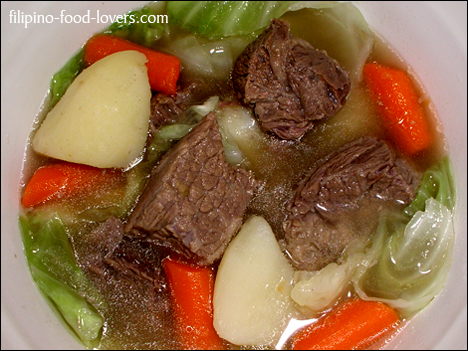Adobo

Adobo is considered a national dish. It is a stew of pork, chicken or
both cooked in soy sauce, garlic, vinegar, whole peppercorns, and bay
leaf. The meat is simmered in the liquid until it is reduced and the
meat is tender. Shellfish and some vegetables can also be cooked this
way.
Sinigang

Sinigang is a local dish using a variety of meats, fish and shellfish
cooked in a sour broth with kamote tops, kangkong, sitaw (string
beans), okra, wing beans, banana hearts, taro roots, sliced eggplants
and radish. The acidity can come from tamarind, green mangoes, guavas,
santol, kamias, young tamarind leaves. Miso and mustard leaves are used
for fish sinigang.
Lechon
Lechon
or litson is a sought-after food during special occasions. A suckling
pig is skewered in a bamboo pole and roasted manually over hot coals
until the skin turns reddish brown and crisp, and the meat tender. It is
served in a thick dipping sauce made from chicken and pork livers,
vinegar, sugar and spices. La Loma in Quezon City is known as the lechon
capital.
Kare-kare
Kare-kare
is a Filipino stew made from beef chunks, tripe, oxtail and a variety
of vegetables. The meat is boiled until tender then mixed with roasted
peanuts and rice/sticky rice, ground to a fine powder that thickens the
sauce and gives it the unique flavor. Nowadays, peanut butter is used in
place of the ground peanuts and rice. The saltiness is derived from the
sautéed shrimp paste (bagoong) that is served with it.
Menudo

Menudo is a staple dish served as everyday fare or during family
gatherings. The Filipino version is a mix of diced pork liver, pork,
onions, tomatoes, potatoes, carrots, red and green bell peppers and
raisins. The rich sauce is thickened with tomato sauce/paste. Cubed
chorizo de bilbao and chickpeas can be added for a richer flavor.
5. Crispy Pata
Crispy
pata means deep fried pata with a crunchy rind and soft and moist meat
inside. Pata is the front or hind leg of the pig. In the Philippines,
that means the leg and the trotters (knuckles).
Kaldereta

Kaldereta is traditionally cooked with goat meat. Nowadays, various
meats can be used. The meat is boiled until tender and slowly cooked
with a very thick sauce made from minced onions, garlic and tomatoes and
ground pepper. The spiciness of the dish varies. Cubes of potatoes and
carrots are sometimes added for variety.
Nilaga

Nilaga literally means boiled. Pork, chicken or beef/beef shanks are
boiled in plenty of water until very tender. Cabbage, potatoes, sweet
potatoes, carrots, leeks, corn, saba, petchay, whole peppercorns and
chick peas are added for a flavorful broth. Nilaga is eaten with fish
sauce or a mashed salad of boiled or broiled eggplants and squash in
vinegar, pepper, garlic, salt and sugar.
Tinapang Bangus

A whole bangus (milkfish) is sliced in half, the gills and innards
removed. Some makers remove the bones. The fish is marinated in salt and
water, drained and cooked in a pressure cooker then dried under the sun
before smoking to complete the cooking process. Oil is applied to the
skin that gives it a shiny texture. Freshly made tinapang bangus are
ready to eat or you can fry it until the skin is crisp.
Pancit

Pancit
or pansit is a Chinese-influence dish served as a main course or snack.
Rice noodles, vermicelli, canton noodles and other dried noodles are
stir-fried together with thinly-sliced pork, pork liver or chicken and
cabbage, Baguio beans and carrots. Calamansi or other acids are served
with pancit to complement the taste.



No comments:
Post a Comment